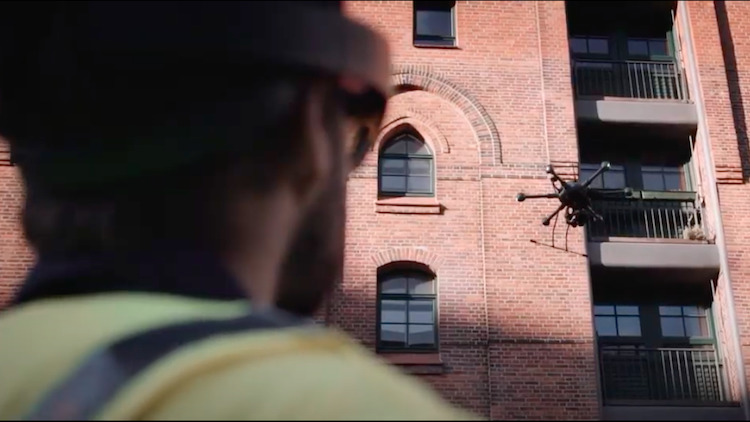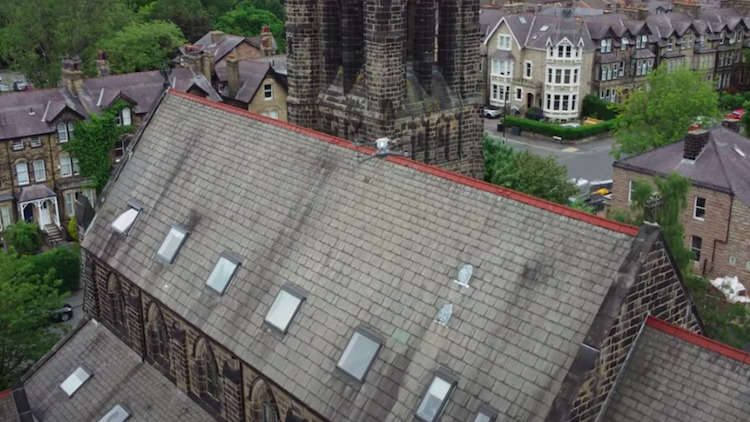
Yorkshire Housing has taken part in a trial to use drone inspections. Denise Chevin asked Darren Williams, lead innovator at the housing association, how it went.
As part of the Drone Pathfinder Catalyst Programme sponsored by the Department for Transport, government agency Connected Places Catapult brought together Yorkshire Housing Association and Vantage UAV to demonstrate and showcase the benefits of using drone services for inspecting buildings and assets.
Connected Places Catapult says it hoped the trial would help catalyse step-change improvements and provide the evidence to encourage more use of drones to drive safety, productivity and efficiency for other housing providers and potentially cut the £6.3bn annual repairs and maintenance bill for social housing providers alone.
Yorkshire Housing estimates that the inspections will provide more than 10 times return on investment by enabling targeted maintenance in place of the extensive roof works that were previously planned. Darren Williams, lead innovator at Yorkshire Housing, says of the trial: “The initial demonstration was very much a standalone proof of concept. That has now shown us the value of using drones to get detailed information quickly and normally more cheaply than previously possible.”
Here he talks in more detail about the initiative.
What were you hoping to get out of it?
With some 18,000 properties across Yorkshire, the housing association was keen to realise the potential of drones, both in reducing the need for expensive scaffolding and using heavy machinery to carry safety checks, and also providing a faster service to residents.
We can see that using drones will allow us to be more responsive in the first place when dealing with roofing repairs and similar works. In the long term, drone technology would allow us to be more pro-active and pre-empt the problems our customers might face, for example by conducting roof surveys and thermal scans in bulk, then using AI to identify problems.
What tasks did you use the drones for – and for any particular properties?
So far we have concentrated on using drones to inspect difficult-to-access buildings, one of which was a converted church (pictured below). The level of detail we were able to capture is amazing.
We are evaluating the results to understand how to take this forward as an organisation.

Is it part of an integrated approach with other automated/digital technologies?
We see drone technology playing a part in there, alongside other technology we are looking at, such as Internet of Things sensors and data analysis.
Can you talk through the results of the trial and benefits that using drones has brought to the maintenance operations?
We inspected three locations over three-and-a-half days. The inspections produced detailed, accessible outputs that Vantage UAV hosted in a browser-based portal and on portable storage drives.
One location had a roof leak and our surveyor was able to identify the cause from real-time footage while the drone was in the air.
With the level of detail captured by the drone, we can more accurately estimate the true cost of the works needed and approach things in a more targeted manner. In particular, the drone captured orthomosaics and 3D models of each site, allowing an overall view of the buildings while allowing viewers to drill down to great detail.
We shared the captured data with specific team members using built-in access controls on the portal. By giving access to surveyors and members of the maintenance teams, they were able to use the outputs within their existing business processes, gaining benefits without requiring fundamental change.
Are there any other learnings or advice that you would share with other housing organisations?
We were worried that our customers may not want drones flying around their homes, due to privacy concerns, but this turned out to not be the case. We wrote to all residents to explain what we were doing and provided a phone number to voice any concerns: we didn’t receive any.
On the day the drones were flying, some residents spoke to the drone pilots, but not with any concerns, just to find out more because they were interested. This has shown us that customers will be more accepting of this sort of technology than we sometimes assume them to be.
What’s next?
We are doing some analysis to understand better how we will use drones within Yorkshire Housing, what type of jobs we will use them for and this will help us work out if we need to partner with a drone operator, or if we need to have in-house drone pilots ourselves.
As the months turn colder, we would also like to carry out some thermal inspections to see what insights we can get from this data about the energy and thermal efficiency of our homes.
What sort of procedures and training have you had to put in place?
None yet, this was just a demonstration. As a team, we need to investigate drones further to understand how they will fit into Yorkshire Housing and what procedures and training is required.














